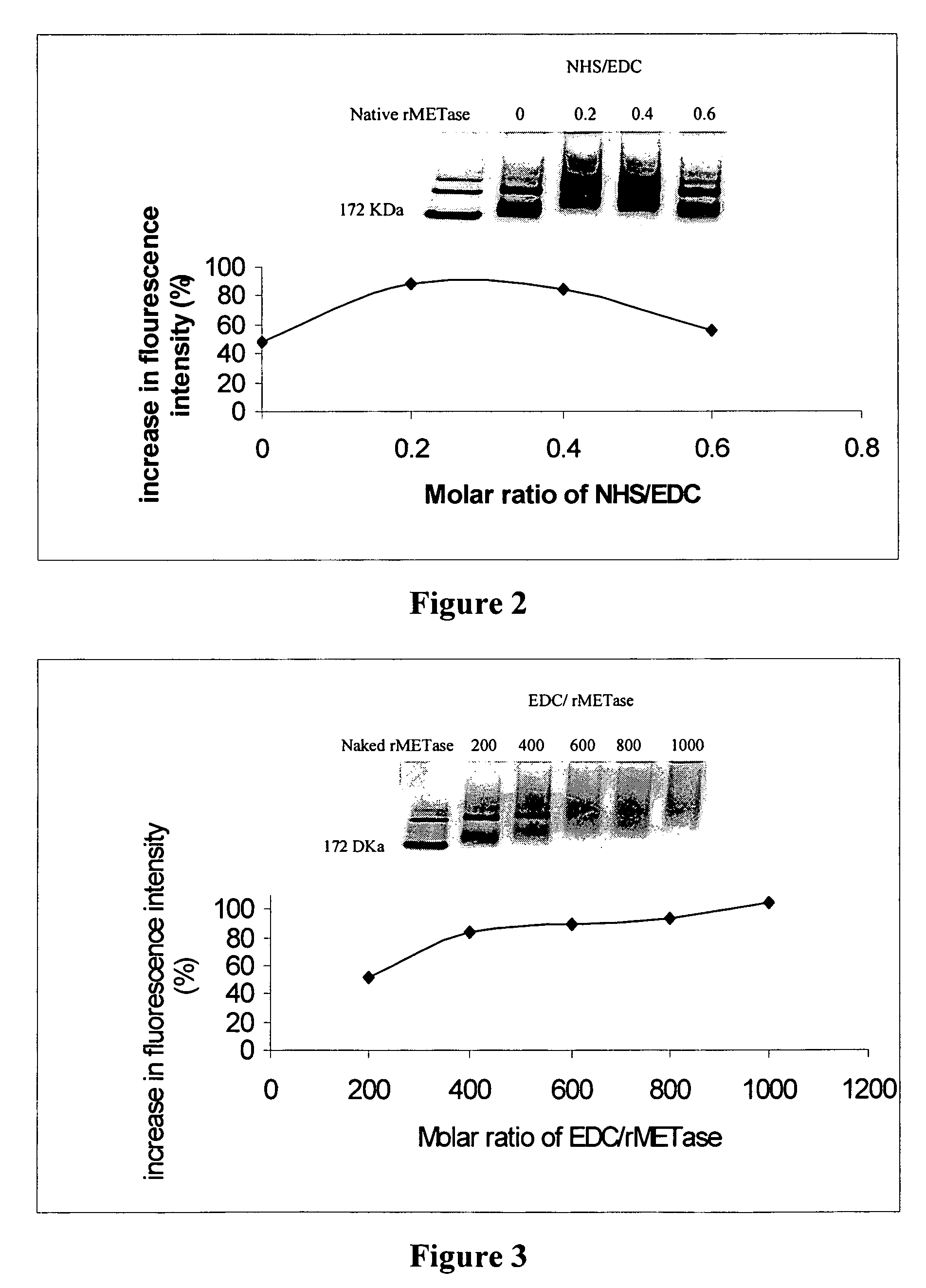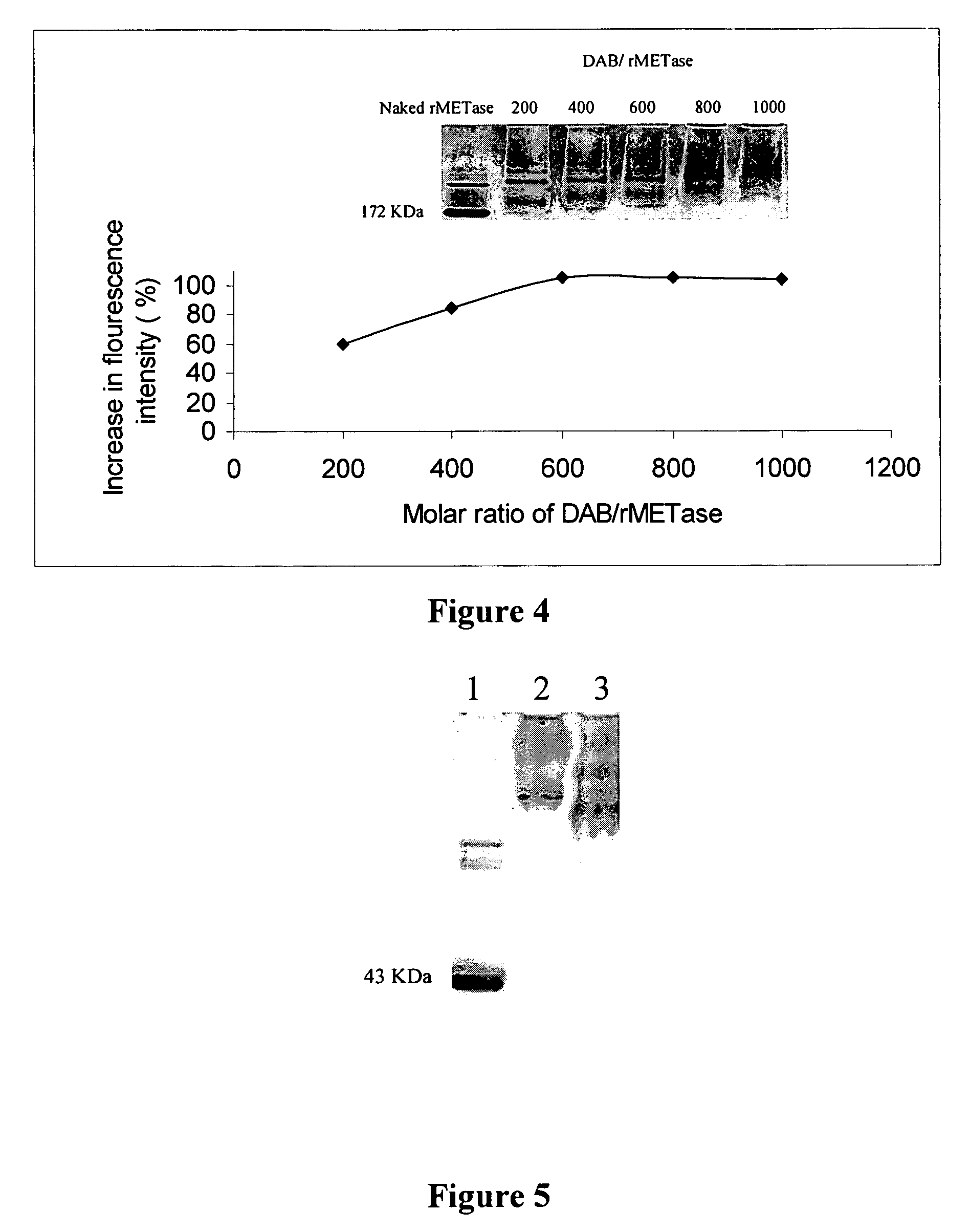Methods for increasing protein polyethylene glycol (PEG) conjugation
a polyethylene glycol and conjugation method technology, applied in the field of protein therapeutics, can solve the problems of limited methods for protein conjugation with peg, and achieve the effect of reducing immunogenicity and increasing the circulating half-li
- Summary
- Abstract
- Description
- Claims
- Application Information
AI Technical Summary
Benefits of technology
Problems solved by technology
Method used
Image
Examples
example 1
Fluorescamine Method to Estimate the Extent of Carboxyl Amidation Groups in rMETase
[0051]The fluorescamine method is usually used to estimate the degree of PEGylation, based on the reduction in fluorescence intensity due to conjugation of amino groups by activated PEG's. Here, the fluorescamine method was used to estimate the extent of carboxyl amidation of rMETase by detecting the increase in fluorescence intensity after rMETase was coupled with diaminobutane (DAB). The assay procedure basically followed the method described by Stocks (Stocks, S. J., et al., Anal. Biochem. (1986) 154:232-234). Briefly, various amounts of rMETase and PEGylated rMETase in 2 ml of 0.1 M sodium phosphate buffer, pH 8.0 were mixed with 1 ml fluorescamine solution (0.3 mg / ml in acetone) and kept for 5 min at room temperature. Samples were then assayed with a fluorescence spectrophotometer at 390 nm excitation and 475 nm emission. Results were plotted as fluorescence intensity versus the concentrations of...
example 2
Reaction Conditions for Carboxy Amidation of r-METase
A. Optimizing the N-hydroxysuccinimide (NHS) 1-ethyl-3-(3-dimethylaminopropyl) carbodiimide (EDC) ratio
[0055]Keeping the molar ratio of rMETase / DAB and rMETase / EDC at 1:600 and 1:800, respectively, the optimal molar ratio of NHS / EDC was determined. DAB (14.1 mg), along with varying amounts of NHS, 4.0 mg, 2.7 mg, 1.3 mg, and 0 mg, respectively, (corresponding to NHS / EDC ratios of 0.6, 0.4, 0.2, 0, respectively) were dissolved in distilled water. The pH of each solution was adjusted to 6.5 with 0.5 N NaOH, to obtain a final volume of 1 ml. These solutions were transferred into 4 wells of a tissue culture plate. Then 25 mg of rMETase in 0.5 ml of 0.2 M sodium phosphate buffer (pH 6.5) was added to each well. The carboxyl amidation reaction was started by addition of 22.2 mg EDC. After stirring for 4 h at room temperature, the products were applied on a Sephadex G-25 column previously equilibrated with 0.1 M, pH 7.4 PBS to remove sma...
example 3
Preparation of Super-PEGylated rMETase
[0058]Super-PEGylated rMETase with more PEG chains than that previously obtained with non-carboxyl-amidated rMETase was prepared following a three-step procedure as shown in FIG. 1. To introduce additional primary amines without cross-linking between rMETase molecules, native rMETase was first PEGylated, which subsequently enabled carboxyl amidation without cross linking. Finally, the carboxyl-amidated r-METase was “super”-PEGylated. For the initial PEGylation step, two ml (200 mg) of rMETase in PBS (0.1 M, pH 7.4) was adjusted to pH 8.5 with 0.5 N NaOH, and then reacted with 87.2 mg of MEGC-5000 PEG (molar ratio of PEG to rMETase at 15: 1) with stirring for 1 hr at room temperature.
[0059]To couple DAB to the carboxyl groups of the initially PEGylated rMETase, the reactants were diluted with 4 ml of PBS (0.2 M, pH 6.5) to 8 ml of containing 21.3 mg NHS (NHS / EDC at 0.2), 149.8 mg DAB (rMETase / DAB at 1:600), 178.3 mg EDC (rMETase / EDC at 1:800). Af...
PUM
| Property | Measurement | Unit |
|---|---|---|
| molar ratio | aaaaa | aaaaa |
| molar ratios | aaaaa | aaaaa |
| molar ratios | aaaaa | aaaaa |
Abstract
Description
Claims
Application Information
 Login to View More
Login to View More - R&D
- Intellectual Property
- Life Sciences
- Materials
- Tech Scout
- Unparalleled Data Quality
- Higher Quality Content
- 60% Fewer Hallucinations
Browse by: Latest US Patents, China's latest patents, Technical Efficacy Thesaurus, Application Domain, Technology Topic, Popular Technical Reports.
© 2025 PatSnap. All rights reserved.Legal|Privacy policy|Modern Slavery Act Transparency Statement|Sitemap|About US| Contact US: help@patsnap.com



